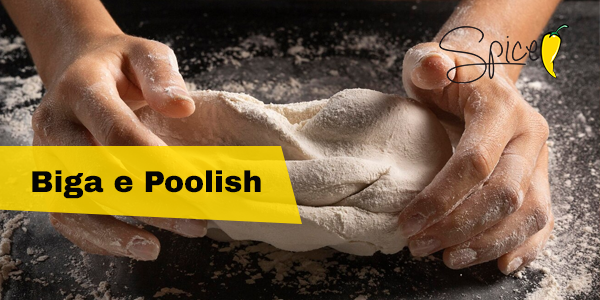- Spice
- Insights
- 9015 views
- 0 comments

In the world of bread making and pizza, pre-fermentation methods such as Biga and Poolish play a crucial role in raising the quality of doughs. Both are considered preferments, i.e. portions of dough prepared in advance and left to ferment for a certain period before being incorporated into the final dough. These processes not only enrich the flavor and structure of the finished product but also contribute to greater digestibility, as well as reducing the need for chemical additives and preservatives, aligning with a growing focus on sustainability and well-being.
Biga
Biga, with its roots deeply anchored in Italian tradition, is widely adopted in the production of bread and pizza. This method is characterized by the use of a high percentage of flour compared to water, generally around 50-60% hydration. Prepared by mixing flour, a modest quantity of yeast (fresh or dry), and water, Biga ferments for a period that can extend from a few hours to over 24 hours. This slow, controlled fermentation not only develops complex flavors but also improves the elasticity and strength of the dough, resulting in a pizza with a crispier, more honeycomb crust.
Poolish
Poolish, which found its origins among 19th-century French bakers inspired by Polish baking techniques, has a runnier consistency than Biga, thanks to a 1:1 flour-to-water ratio. This preferment, also enriched by a small quantity of yeast, is left to ferment for periods similar to Biga, typically between 12 and 16 hours. The high hydration of Poolish promotes the development of a slightly more acidic flavor and greater extensibility of the dough, making it particularly suitable for pizzas with a light, soft and porous crust.
Impact on Pizza
The use of Biga or Poolish in pizza dough offers numerous advantages:
Taste: Both methods intensify the flavor profile of the pizza, resulting in richer, more complex flavors and aromas thanks to prolonged fermentation.
Structure and Texture: Pre-fermentation contributes to a greater definition of the honeycomb structure, with large pores and a crunchy crust.
Digestibility: The fermentation process facilitates the degradation of gluten and starches, and reduces phytates, improving both digestibility and absorption of minerals.
Choice between Biga and Poolish
The decision to use Biga or Poolish depends on individual preferences, the type of pizza desired, and the specific characteristics you want to impart to the dough. While Biga is often chosen for pizzas that require greater crunchiness and structure, Poolish is ideal for those who want a softer, lighter crust.
In conclusion, both the Biga and the Poolish offer pizza makers valuable tools to improve the quality of their pizza, encouraging the exploration of different textures, flavors, and processing techniques. The interaction between tradition and innovation, through the adoption of modern technologies in baking, makes these techniques even more accessible and versatile, allowing bakers and pizza makers to experiment and customize according to their needs.

Comments (0)
New comment